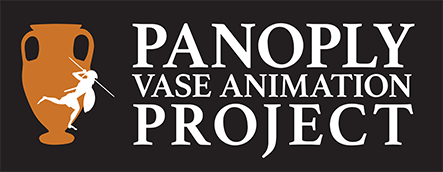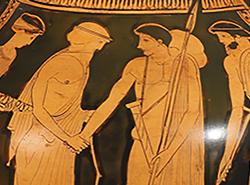Palamedes. Games Master begins by taking an image of Palamedes at his boardgame and going back in time to the moments before his inspired invention of the game. We see him walking through the Greek camp. This involves a mixing of worlds, with the vase figure represented under a realistic night sky. Behind him we see some of his fellow-soldiers silhouetted in the darkness.
Palamedes sees a flock of birds flying above him in the triangular shape of the letter delta (D). He is inspired by the shape, and he realises the importance of signs and symbols. Letters appear to fall from the sky into his hand. He brings them to his new boardgame board, and begins to set out the letters and game counters. He rolls the dice and begins to play. The game pieces each represent a warrior. Palamedes sees the counters leap up in warrior form and begin to fight.
The animation finishes with a quotation from Gorgias’ Apology of Palamedes. This text imagines Palamedes defending himself when he is accused by the Greek army. You can see more about this in the Palamedes PowerPoint (on the Further activities tab).
The music was created for this animation by Edwan (www.edwanmusic.com).
This animation was created with French text for the 'De la case au pixel' exhibition at the Swiss Museum of Games. https://museedujeu.ch/fr/. It is a part of the project: Locus Ludi. The Cultural Fabric of Play and Games in Classical Antiquity, https://locusludi.ch.
The animation reflects research into the relationship between the abacus and games, which is the key topic of the Swiss Museum of Games exhibition. It reflects the special ability of games to bring soldiers together and ease social tensions.
Reasearch papers:
Dasen, V., and Gavin, J., “Game Board or Abacus? Greek Counter Culture Revisited”, in Caré, B., Dasen, V., Schädle, U. (eds), Back to the Game: Reframing Play and Games in Context, Lisbon, Associação Ludus, 2021, 227-271 Open Access: https://sciendo.com/it/article/10.2478/bgs-2022-0009 (= Board Games Studies Journal, 16, 1, 2022, 251-307).
Nicot, F., "Voici la plus ancienne représentation d'une leçon de maths datant de la Grèce antique (et vous allez tout comprendre !)", Sciences et avenir 06.05.2022. https://www.sciencesetavenir.fr/archeo-paleo/archeologie/voici-la-plus-ancienne-representation-d-une-lecon-de-maths-datant-de-la-grece-antique-et-vous-allez-tout-comprendre_163309.
Lapirot, O., “La plus vieille leçon de maths”, an interview V. Dasen and J. Gavin, Sciences et Vie Junior, 399, 2022, 38-41 https://zenodo.org/records/7504834#.Y7YEhOzMJ10.
Vespa, M., “Les effets néfastes de la kubeia. Mise en jeu du prestige et de l’image sociale en Grèce classique”, in Dasen, V., Vespa, M. (dir.), Dossier: Bons ou mauvais jeux ?, Pallas, 114, 2020, 173-192 https://journals.openedition.org/pallas/19080.
Vespa, M., "Tales of Imitation: Palamedes, the Cranes, and Interspecies Learning in Greco-Roman Antiquity", Illinois Classical Studies, 47, 2, 2022, 406-431 https://muse.jhu.edu/article/916494.
On Palamedes' inventions:
Vespa, M., “La sagesse de Palamède: les dés, les pions et l’établissement d’un ordre (à propos de Philostrate, Sur les héros, 10 Follet)”, in Dasen, V., and Bouvier, D. (eds) Héraclite: Le temps est un enfant qui joue, Collection Jeu/Play/Spiel 1, Presses Universitaires de Liège, 2020, 75-94 https://zenodo.org/records/4536216#.Yp-7NuxBx10.
Vespa, M., “Au commencement était la faim. Récits sur l’origine des jeux dans l’Antiquité grecque et romaine”, in Dasen, V., and Vespa, M. (eds.) Play and Games in Classical Antiquity: Definition, Transmission, Reception, Collection Jeu/Play/Spiel 2, Presses Universitaires de Liège, 2021, 125-145. https://zenodo.org/records/6464634#.YlqhnvNBxFk.


